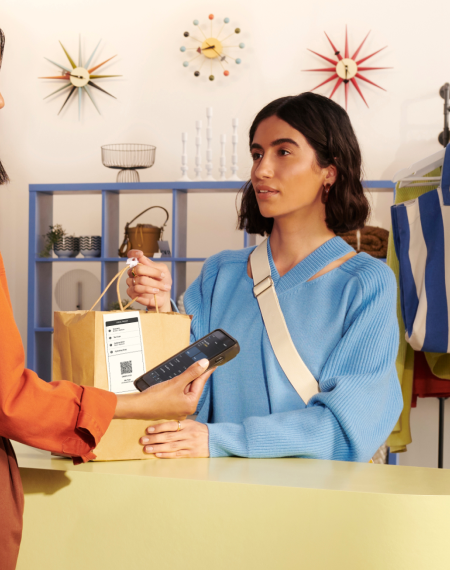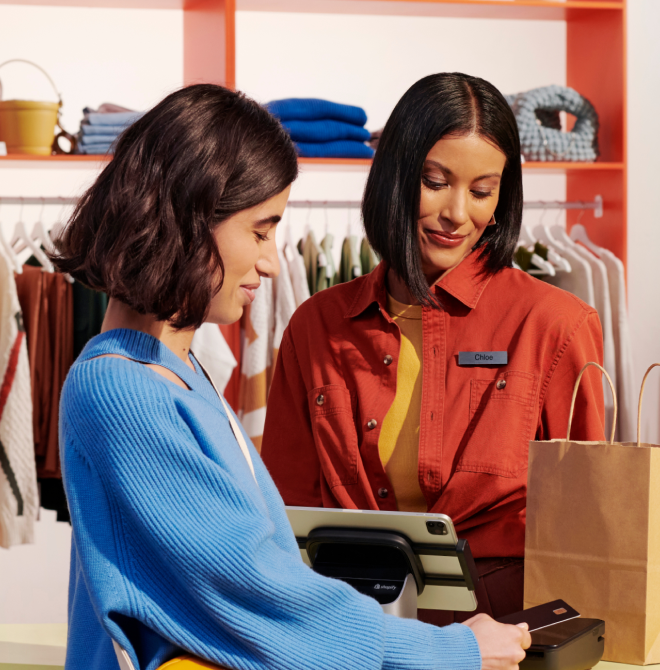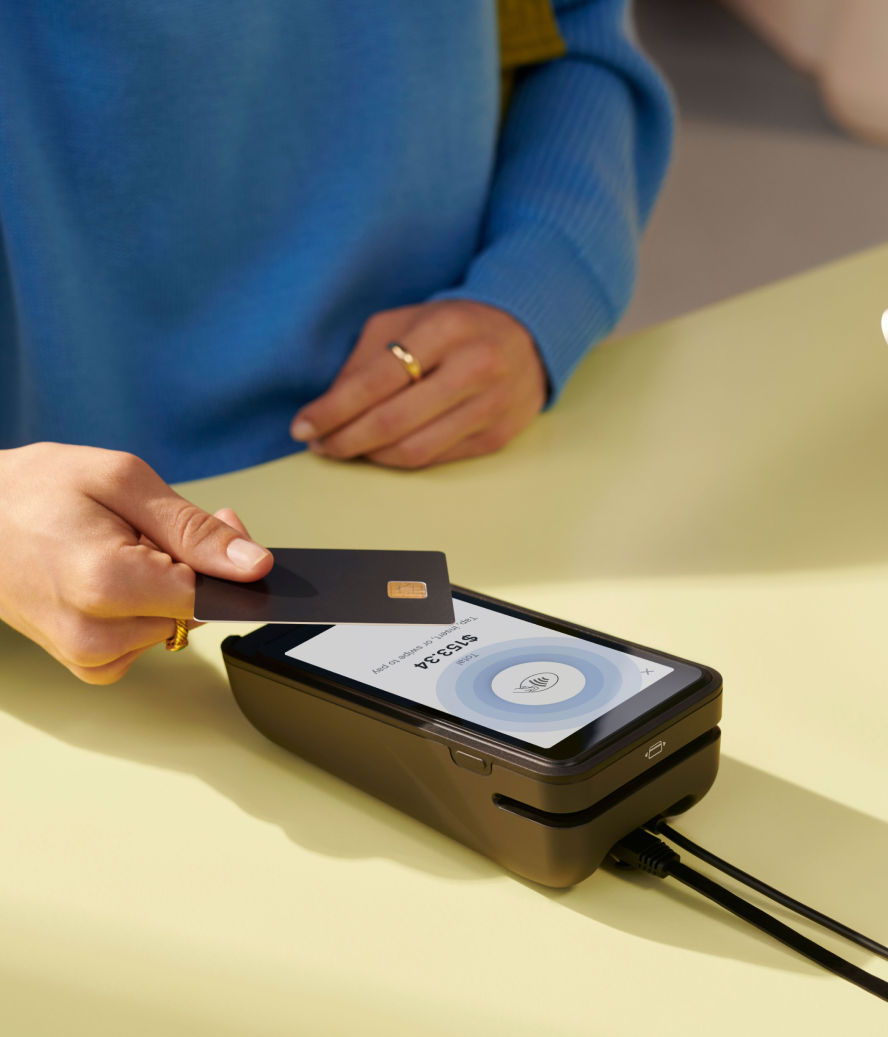Radio-frequency identification (RFID) technology is a way for retailers to identify items using radio waves. It transmits data from a RFID tag to a reader, giving you accurate, real-time tracking data of your inventory.
The decades-old technology evolved from its roots in World War II radar systems, and later in the 1970s when RFID tags were used to monitor railway carriages. Since then, RFID has evolved beyond a niche technology to a must-have for modern retail operations, driven by the growing need for supply chain visibility and inventory accuracy.
Want in on the action? Learn how RFID technology works, its advantages for retailers, and how you can use RFID technology in your store.
What is RFID technology?
RFID belongs to a group of technologies called automatic identification and data collection (AIDC), which you can use to identify items, collect data about them, and send that data to a computer system, with little human interaction.
RFID consists of two main parts:
- Readers: Fixed or mobile devices with one or more antennas that send and receive electromagnetic signals back from RFID tags
- Tags: Electronic devices that contain RFID chips or integrated circuits (IC), which store a serial number or unique identifier and use radio frequency waves to communicate data to the reader
For retailers that need to track inventory accuracy, an RFID system that integrates with your inventory can increase efficiencies significantly. You can use it to improve inventory accuracy and visibility to create better shopping experiences for today’s omnichannel shoppers.
RFID vs. barcodes
Barcodes are a retail staple for pricing and inventory tracking, but they can only be scanned in one direction and hold limited information. RFID tags offer more efficiency than traditional barcode scanning as they have a larger read range, can hold much more data, and don’t require a line of sight. Plus, they keep data safe via encryption and can handle exposure to weather conditions, making them more durable and secure.
RFID vs. NFC
NFC is a type of RFID that allows two-way communication, meaning both the scanner and the tag can send and receive data. Unlike standard RFID, which has a longer reading range, NFC works at close range, enabling contactless or tap-to-pay functionality, such as when a customer taps their phone or card to pay with Apple Pay.
How does RFID technology work?
RFID systems have three components that make them work: an antenna, a transceiver, and a transponder (tag). The part of the tag that encodes the data is called the RFID inlay. When you combine the antenna and the transceiver, you have an RFID reader, also known as an interrogator.
There are two types of RFID readers:
- Fixed readers, in which the reader and antenna are installed in a specific place where RFID tag data passes. For example, you can check out at Amazon Go without going to a cashier—you just walk through an RF zone and the reader receives the tag data.
- Mobile readers, which are handheld devices that can be carried anywhere
There are two common types of RFID tags:
- Active RFID tags: Tags that have their own power source and can read within a range of 100 meters or more. Active tags are used by companies for which asset location or logistics improvements are important.
- Passive RFID tags: Tags that don’t have a power source. Electromagnetic energy from the reader powers a passive RFID tag. This gives them a read distance from close contact up to 25 meters. These tags also operate at different frequencies, which impacts range: the higher the frequency, the farther the scanning range.
There are also semi-passive RFID tags, which work like passive tags but include a battery to extend their range. Passive tags remain the most common choice because they’re small, lightweight, and affordable, and last more than 20 years. And since they’re low-cost and disposable, suppliers often attach them to product cases that get discarded after unpacking.
Once you have the RFID equipment, the tracking process can be broken down into the following phases:
- An RFID tag is attached to an object, such as a product, animal, or person.
- The tag contains a microchip with stored information.
- An antenna identifies and sends a signal to power the nearby RFID tag.
- The tag's chip accesses its built-in memory and sends data back to the antenna.
- The antenna picks up the data stored on the RFID tag and sends it to a reader.
- The reader connects wirelessly to the antenna and receives the information stored on the RFID tag.
- The reader interprets the data and sends it to a host system or database for storage and evaluation.
What is RFID technology used for?
RFID technology is used in industries like healthcare, automotive, consumer packaged goods, aerospace, and transportation. In retail settings, RFID uses include the following:
Enhance store operations
RFID provides real-time inventory visibility, which helps retailers minimize stockouts, optimize shelf space, and streamline operations.
When paired with Shopify POS, it automates sales tracking, returns, and restocking, which reduces labor costs and prevents shrinkage. And with Shopify’s unified inventory view, staff can quickly locate products, keep shelves stocked, and spend more time creating standout customer experiences.
Analyze in-store traffic patterns
You can use RFID to track item movement throughout a store. With this information, you can learn your store’s high-traffic end caps, pinch points, and different employee and product paths throughout the day.
Offer contactless payments
Contactless payments include any transaction completed using a mobile phone, a contactless-enabled debit or credit card, or a key fob. Once a customer is done shopping, they can walk through an RFID checkout, verify their identity using biometric scanners, and pay for items.
Assist stock picking
Advancements in technology mean retailers can store goods vertically, rather than horizontally, and RFID technology can help with stock picking. RFly, for example, created a drone that scans RFID tags and locates products inside a warehouse. If the item is stacked on a high shelf, the drone will collect it.
Track the temperature of goods
Certain products—including perishable goods—need to be stored at specific temperatures. Sensors within the RFID product tags can monitor temperature and keep a log of it inside the tag.
Supply chain tracking
RFID tags power real-time inventory management, product authentication, and theft prevention by storing and transmitting data across the supply chain. This gives retailers better visibility and control over their operations.
Asset tracking
RFID automatically scans and updates asset locations in real time, reducing the potential for human error while cutting labor costs. By combining sales data and video surveillance, RFID helps retailers detect theft, track stolen items, and even support law enforcement in recovery.
Patient tracking and safety
In the healthcare sector, RFID technology boosts efficiency by tracking patients, ensuring accurate medication dispensing, securing sensitive areas, and monitoring medical equipment. It also enhances patient safety by verifying identities before treatments, which reduces errors and improves overall quality of care.
Access control
Beyond inventory management, RFID also strengthens retail security by restricting unauthorized access to sensitive areas such as stockrooms and warehouses. RFID badges, wristbands, and key fobs ensure only authorized personnel can enter restricted spaces, reducing theft risks.
Benefits of RFID technology
The usage of RFID technology in the Internet of Things (IoT) space is growing as shoppers expect retailers to embrace the latest tech for a smarter, more seamless shopping experience.
One report found that 61% of retailers are increasing their investment in RFID technology. Another 42% plan to adopt the technology within the next three years. Let’s take a look at why.
Improved inventory management
RFID helps retailers accurately monitor stock levels, tracking details such as quantities, models, colors, and sizes, and quickly identifying discrepancies. This prevents stock issues and cuts down on manual work, so employees can focus on sales and customer service. With a handheld RFID scanner, for instance, you can process multiple items in minutes, enabling faster and more frequent stock takes.
RFID also streamlines inventory management by automating shipment receipts, triggering reorders based on live data, and enabling quicker, more precise cycle counts.
Improved loss prevention
Retailers facing rising costs and supply chain interruptions have an increasing need to reduce the amount of shoplifting and employee fraud in their stores—a $112.1 billion problem.
RFID tracks asset movement and integrates with sales and video data, giving retailers a clearer picture of shrinkage patterns so they can curb theft, reduce administrative error, and strengthen overall store security. Pairing RFID systems with artificial intelligence (AI) in retail settings offers real-time inventory tracking that provides information on which item was stolen, removes it from the local inventory, and automatically reorder a replacement.
Faster checkout
Checkout is one of the biggest friction points in retail, and experts predict the future of shopping may not include checkout at all. That’s why more retailers are doubling down on ways to streamline the process, reduce friction, and take more control over the customer journey.
RFID is leading this shift, enabling contactless, automated payments that speed up transactions, reduce cart abandonment, and improve the shopping experience.
Amazon Go's "Just Walk Out" system is a prime example. Shoppers use a credit card, app, or Amazon One to enter a store and grab what they need. Cameras and sensors track their selections and charge them automatically, creating a frictionless, time-saving shopping experience.
Increased efficiency for buy online, pick up in-store (BOPIS)
Buy online, pick up in-store (BOPIS) is a must-have for retailers looking to bridge the gap between online and in-store shopping. It’s a cost-effective fulfillment option that saves on last-mile delivery expenses while increasing footfall to physical stores. By October 2024, more than 10% of orders were picked up in-store, proving just how crucial flexible fulfillment has become.
RFID ensures retailers can deliver on BOPIS promises by providing real-time inventory visibility. Without accurate stock data, stores risk selling items for pickup that aren’t actually available. RFID prevents these errors, ensuring a smooth experience for customers and staff alike.
Examples of RFID tags and technology in retail
Retailers are always looking for ways to test and implement technology to operate more efficiently, set themselves apart from the competition, and improve the shopping experience.
Most retailers see RFID technology as a clear path to more accurate inventory counts—but some innovative retailers use it for more than simple inventory management.
Not sure how radio-frequency identification technology could fit into your business strategy? Here are four innovative examples of how RFID technology can be put to work in retail.
1. Baroque Japan
Baroque Japan, a Japanese fashion retailer, recently introduced an RFID-based application from RFLocus that locates and provides visibility of inventory in 150 of their 700 stores.
The P3 Finder app enhances the existing RFID solution and enables Baroque Japan to serve the demand for buy online, pick up in-store (BOPIS) by keeping inventory counts at each store accurate and up to date.
The app is integrated with Sensormatic’s TrueVUE Cloud software, which enables Baroque Japan’s staff to more easily find items required for restocking in stores. The P3 Finder app uses 3D radar to show the item’s location in the warehouse and store, and enables staff to know how close they are to any items at any given time.
2. Ralph Lauren’s virtual fitting rooms
Luxury retailer Ralph Lauren created their own in-store fitting rooms. Customers step into interactive fitting rooms to try on their merchandise for size.
A virtual “smart-mirror” screen uses RFID technology to read digital data from inside a clothing tag. It uses that data to present an overlay of the product on a live image of the customer.
These special fitting room mirrors allow shoppers to get a 360-degree view of what they’re trying on, and even to change the color or pattern of the clothing with a simple gesture.
The technology also helps the retailer provide a level of personalization that can build loyalty and keep customers coming back for more.
3. Advanced Apparels’ RFID stock locator
Retailers are investing millions in integrated RFID solutions that minimize out-of-stock situations, provide real-time merchandise location data, and improve the customer experience. The technology allows them to track their inventory throughout the retail supply chain, from the warehouse shelves all the way to the sales floor.
Clothing wholesaler Advanced Apparel is one of the brands using RFID technology in this way. The merchant uses RFID to pinpoint where its goods are located within a warehouse—down to the rack or shelf it’s stored on.
This use case is a huge timesaver for brands with thousands of SKUs. In Advanced Apparel’s case, searching 6,000 SKUs for a single item is unproductive and not cost-effective.
The best part? Advanced Apparel added its own direct-to-consumer website earlier this year to coexist with its wholesale business and dropshipping partners. Now that the brand uses RFID to store and locate goods, it has an always-updated inventory count to sell omnichannel.
4. Unilever’s Ice Cream Shop
Unilever’s Ice Cream Shop mobile stores in West Hollywood have partnered with Robomart to offer on-demand ice cream deliveries, which will be tracked via radio frequency identification (RFID) technology.
Robomart’s temperature-controlled vehicles, which are each filled with RFID-tagged ice cream products, will be available for order through an app.
The system will enable real-time inventory tracking and purchasing data and provide product tracking and sales data analytics. Customers can order ice cream any time and pay for goods using the Robomart app.
Integrating RFID into your retail store
The retail industry is still in the early days of mass RFID adoption. Granted, the cost of implementing RFID technology is a worry for some retailers. Yet with the lower barrier of installation and the rising impact of shopper expectations, acceptance is inevitable in the coming years.
If you’re unsure, start small. Use RFID tags to locate inventory in your storeroom or warehouse. Analyze your peak shopping times for each store. And if you really want to push the boat out, create a virtual mirror that scans RFID tags and overlays what the product would look like on a customer.
Remember: Technology isn’t something to fear. When humans and RFID technology work together, merchants can save time, become more productive, and save money.
Read more
- What Are Virtual Fitting Rooms and How Do They Work? (2024)
- Retail Technology: Upgrade Your Toolstack With These 6 Trends
- What is an Inventory Specialist and How to Hire One
- A Simple Guide to Cycle Counting in Retail (+ Best Practices & Benefits)
- What Causes Shipping Delays? How They Impact Retailers and How to Deal With Them
- Diversify Your Offerings: Takeaways From 5 Service-Based Businesses Turned Retailers
- What is Overselling (+ How to Prevent It)
- Inventory Reporting 101: A Retailer's Guide to Reporting on Inventory
- What Is Economic Order Quantity and How Can I Calculate It?
- Inventory Accuracy: How to Identify & Solve Discrepancies in Stock Levels
RFID technology FAQ
Does my credit card have RFID?
If your credit card has a contactless indicator—a sideways WiFi symbol on the front or back—it likely has RFID. Try tapping or waving your card at a payment terminal with the same symbol. If the payment goes through, the card is RFID-enabled.
Is RFID theft a thing?
RFID theft is technically possible but rare and difficult to pull off. A thief would need to get within inches of your card with an RFID reader, and even then, weak signals, interference from other cards, and one-time security codes make stealing usable data nearly impossible. Keeping your card in a wallet or bag is usually enough protection. But, if fraud ever happens, report it immediately to your bank or card issuer.
Is RFID still used today?
Yes, RFID is still widely used, with the market set to hit $26.66 billion by 2032. Its precision in inventory management and impact on checkout efficiency keep it in high demand, with 42% of retailers planning investments in RFID tech within the next three years.
What are the risks of RFID?
RFID technology risks include unauthorized access and tag cloning, which can lead to data breaches or inventory manipulation. Investing in advanced RFID solutions and robust security measures like encryption, access controls, and regular software updates can protect inventory and sensitive data while maintaining customer trust.





